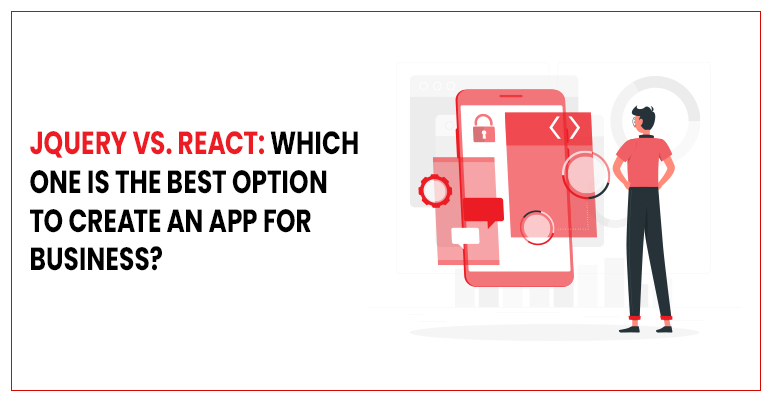JQuery Vs. React: Which One Is the Best Option to Create an App for Business?
August 10, 2021
admin
React, and jQuery and JavaScript libraries are known for delivering similar results via distinct methodologies. Both of these libraries have advantages and disadvantages that are distinct from one another. The debate between jQuery and react is lengthy. We have, however, identified particular distinctions and similarities amongst them. Let’s get started!
When jQuery was first released in 2006, JavaScript was not nearly as popular as it is now. Developers widely accepted it because it allowed them to integrate HTML within JavaScript. jQuery changed the course of web user interfaces by enabling developers to create interactive experiences quickly and efficiently. Simply put, jQuery aided in the revolutionization of the business by assisting developers in the transition from producing basic websites to excellent web apps. React was first developed in 2013, and by 2016, it has amassed a sizable following. HTML’s intuitive and straightforward manipulation allows developers to create advanced and sophisticated single-page apps.
WHAT EXACTLY IS JQUERY?
jQuery is a JavaScript library designed to be ‘lightweight.’ JavaScript was not extensively utilized or even straightforward when it was first released in 2006. However, by wrapping several lines of JavaScript code into functions that can be called with a single line of code, jQuery transformed the business. To define jQuery, the term “write less, do more” can be used entirely. It also simplifies several sophisticated JavaScript calls, such as AJAX and DOM manipulation. As a result, switching from regular web pages to constructing dynamic web apps was a breeze. jQuery is the most popular and extensible JavaScript library to date. On the web, jQuery is used by many large firms like Google, Microsoft, and IBM.
FEATURES OF JQUERY.
- HTML/DOM manipulation is supported by jQuery.
- It can also be used to wrap HTML event methods.
- It allows you to manipulate CSS.
- jQuery makes it easier to use effects and animations.
- On jQuery, AJAX calls are more straightforward.
- It’s a collection of different utilities, including plugins for practically every task you can think of.
- On practically all significant browsers, jQuery behaves the same way.
WHAT EXACTLY IS REACT?
Facebook built React in 2011 as an open-source, declarative, fast, and incredibly flexible JavaScript toolkit, primarily to create interactive UI elements. UIs were formerly built by hand using raw JavaScript or React precursors like jQuery, which took longer and were less accurate. All of that changed when React was introduced. React delivers reusable library code, which reduces overall development time while also reducing the scope of faults. Developers may utilize React to create large-scale, dynamic-looking single-page applications that are sophisticated but simple to use.
JSX and Virtual DOM, in addition to these, are two significant features that set React apart from other libraries. React is used by companies such as Airbnb, TripAdvisor, and, of course, Facebook and Instagram.
FEATURES OF REACT
- Using React gives developers access to React code snippets and components, allowing them to design UI aspects.
- You can directly manipulate the DOM using JSX.
- It also includes a Virtual DOM to boost website performance. It is an open-source project.
- Whatever unique UI function a developer has to handle, there is a React module for it.
- The React library, as well as the community’s vetted library add-ons, is rapidly expanding.
COMPONENTS OF THE USER INTERFACE
React is a JavaScript library for creating user interfaces for single-page web apps. You can use it for non-single-page apps, although it may be redundant or overdone, depending on the situation. Some consider jQuery to be more of a helper library because it provides functions for completing various everyday tasks in your code. One of the most notable features of jQuery was that it provided a user interface for dealing with inconsistencies. However, it is no longer relevant because all browsers now function similarly.
You will gain an advantage if you learn both. In this aspect, neither of them can be labeled the winner because their purposes are so dissimilar. You’ll be able to make the best decision if you understand the fundamentals of both libraries.
USER-FRIENDLINESS
This one is a little more difficult to answer because these libraries are utilized for different purposes. If you want to give your business website some personality, jQuery is the way to go. For example, you are adding an animated menu for navigation and a trigger event button.
Complex web apps with several views and advanced functionality cannot be built with jQuery. React, on the other hand, is the undisputed king of complicated web app development. Why, exactly, is the question? On the other hand, react was created to meet web apps like other web applications. Also, how you employ its components influences the development process of your web application, among other things.
JOB OPPORTUNITIES
React has come a long way and is now used by many well-known web applications. CarMax, Instagram, Facebook, Dropbox, Netflix, TripAdvisor, Zillow, and Airbnb are a few examples of prominent business apps. React has a higher adoption rate than jQuery, and there is a greater demand for React engineers currently than in previous years. jQuery has a smaller job market than React. It’s more up-to-date, and don’t forget that large-scale developers are aware of Reacts potential.
IN KB, THE SIZE OF THE LIBRARY.
The most crucial aspect to consider is the size of both jQuery and react in KB. The fundamental purpose of a web app developer is to create the most significant possible user experience. If a program takes an age to load, users will feel frustrated. Nobody wants to visit a page that isn’t mobile-friendly. The majority of people are unaware that React has a vast and bloated library. It may not seem like much of a difference to some, but using a 3G network on your mobile device reduces loading time by 20%, which is a significant difference.
LIBRARY SERVICES PROVIDED BY OTHERS
Because of the nature of web development, if you want to upgrade or add functionality to your application, the chances are that another developer has already played that card and has made it available as a library for other developers. The Node Package Manager is a well-known JavaScript library source that is used all around the world. Node Package Manager was released in 2010, a year after jQuery was released, in 2006. Given jQuery’s age, you should expect some more complex libraries to be accessible. However, when it comes to the number of third-party libraries available, React comes out on top.
In terms of technical merit, there is no clear winner in the jQuery vs. React debate because they are both employed to solve different programming problems. However, React is superior to JQuery because it is a modern library with a large developer community. Because React has a bright future, developers may be forced to switch to it sooner rather than later.
ENDNOTE
WHICH IS BETTER, JQUERY OR REACT?
If you’re a developer of a top mobile app development services company, the issue is critical because each platform is better suited to its field. While jQuery is a good alternative for easy web development with animations and effects, React allows you to accomplish more complex tasks and focuses on UI development, DOM manipulation, and the like. Even though jQuery is still widely used, React, funded by Facebook, is rapidly gaining traction and appears to stay in the following years. However, when it comes to work factors and career chances, React wins the game and has a bright future ahead of it.





